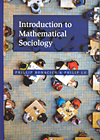- About MAA
- Membership
- MAA Publications
- Periodicals
- Blogs
- MAA Book Series
- MAA Press (an imprint of the AMS)
- MAA Notes
- MAA Reviews
- Mathematical Communication
- Information for Libraries
- Author Resources
- Advertise with MAA
- Meetings
- Competitions
- Programs
- Communities
- MAA Sections
- SIGMAA
- MAA Connect
- Students
- MAA Awards
- Awards Booklets
- Writing Awards
- Teaching Awards
- Service Awards
- Research Awards
- Lecture Awards
- Putnam Competition Individual and Team Winners
- D. E. Shaw Group AMC 8 Awards & Certificates
- Maryam Mirzakhani AMC 10 A Awards & Certificates
- Two Sigma AMC 10 B Awards & Certificates
- Jane Street AMC 12 A Awards & Certificates
- Akamai AMC 12 B Awards & Certificates
- High School Teachers
- News
You are here
Introduction to Mathematical Sociology

Publisher:
Princeton University Press
Publication Date:
2012
Number of Pages:
240
Format:
Hardcover
Price:
45.00
ISBN:
9780691145495
Category:
Textbook
[Reviewed by , on ]
Peter Rabinovitch
08/8/2012
The first sentence in the first chapter of Introduction to Mathematical Sociology is “Mathematical sociology is not an oxymoron.” The authors then back up this statement with about 200 pages of ideas and examples, followed by an impassioned plea for students to accept that mathematics has role in sociology. I found it convincing.
This book has similar topics to Easley and Kleinberg’s Networks, Crowds and Markets, but at a much lower mathematical level. For example, eigenvalues are not even defined. This is partially made up for by having several interactive Mathematica demonstrations available, most with accompanying exercises. (Note that these demos do not require Mathematica, but rather the free CDF Player available from Wolfram Research.) Although playing with the demos is not “math,” it can certainly demonstrate to the target audience some interesting phenomena, as well as whet their appetites for a more thorough understanding.
After the introduction, some basic math (set theory, probability, relations, graph theory, and a little linear algebra) are presented before delving into the main topics of the book: weak ties, cliques, centrality, small worlds and scale free networks. This is followed by balance theory, demography, and two chapters on game theory, concluding with one chapter on complexity and chaos.
They book is easy bedtime reading for mathematicians, and a useful introduction for sociology students who are interested in how things like Facebook work. It could also be used for bright high school students who are interested in applications of mathematics to the softer sciences.
There are a few typos; none are showstoppers but I suspect they could confuse neophytes. The table of contents, first chapter and Mathematica demos are available at the publisher’s web site.
Peter Rabinovitch is a Systems Architect at Research in Motion. He recently defended his PhD thesis on Mallows permutations, and is still trying to condense it into something readable.
List of Figures ix
List of Tables xiii
Preface xv
Chapter 1. Introduction 1
Epidemics 2
Residential Segregation 6
Exercises 11
Chapter 2. Set Theory and Mathematical Truth 12
Boolean Algebra and Overlapping Groups 19
Truth and Falsity in Mathematics 21
Exercises 23
Chapter 3. Probability: Pure and Applied 25
Example: Gambling 28
Two or More Events: Conditional Probabilities 29
Two or More Events: Independence 30
A Counting Rule: Permutations and Combinations 31
The Binomial Distribution 32
Exercises 36
Chapter 4. Relations and Functions 38
Symmetry 41
Reflexivity 43
Transitivity 44
Weak Orders-Power and Hierarchy 45
Equivalence Relations 46
Structural Equivalence 47
Transitive Closure: The Spread of Rumors and Diseases 49
Exercises 51
Chapter 5. Networks and Graphs 53
Exercises 59
Chapter 6. Weak Ties 61
Bridges 61
The Strength of Weak Ties 62
Exercises 66
Chapter 7. Vectors and Matrices 67
Sociometric Matrices 69
Probability Matrices 71
The Matrix, Transposed 72
Exercises 72
Chapter 8. Adding and Multiplying Matrices 74
Multiplication of Matrices 75
Multiplication of Adjacency Matrices 77
Locating Cliques 79
Exercises 82
Chapter 9. Cliques and Other Groups 84
Blocks 86
Exercises 87
Chapter 10. Centrality 89
Degree Centrality 93
Graph Center 93
Closeness Centrality 94
Eigenvector Centrality 95
Betweenness Centrality 96
Centralization 99
Exercises 101
Chapter 11. Small-World Networks 102
Short Network Distances 103
Social Clustering 105
The Small-World Network Model 111
Exercises 116
Chapter 12. Scale-Free Networks 117
Power-Law Distribution 118
Preferential Attachment 121
Network Damage and Scale-Free Networks 129
Disease Spread in Scale-Free Networks 134
Exercises 136
Chapter 13. Balance Theory 137
Classic Balance Theory 137
Structural Balance 145
Exercises 148
The Markov Assumption: History Does Not Matter 156
Transition Matrices and Equilibrium 157
Exercises 158
Chapter 15. Demography 161
Mortality 162
Life Expectancy 167
Fertility 171
Population Projection 173
Exercises 179
Chapter 16. Evolutionary Game Theory 180
Iterated Prisoner's Dilemma 184
Evolutionary Stability 185
Exercises 188
Chapter 17. Power and Cooperative Games 190
The Kernel 195
The Core 199
Exercises 200
Chapter 18. Complexity and Chaos 202
Chaos 202
Complexity 206
Exercises 212
Afterword: "Resistance Is Futile" 213
Bibliography 217
Index 219
- Log in to post comments




